What is the Burton Step On system?
The Step-On system are a group of specific boots and bindings, that mean you are able to quickly and easily get in and out of your bindings, without the need for traditional straps.
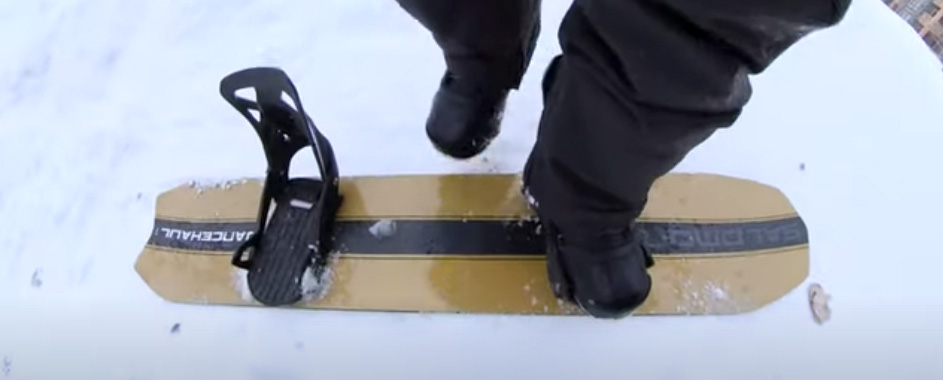
Pros
Quick and easy to get in and out of the bindings at the top and bottom of every run.
Cons
Price. You do pay a extra for the convenience. Even when there is the same model in the regular line, and in the Step-On – the Step On version costs more.
Here is a real con – You spend a lot of time waiting around for your friends to strap in. This one seems obvious, but it actually does take everyone a long time to get ready with regular bindings for each run, and Step-Ons really highlight that.
Once you get into the Step-On system, you are locked in. If you have Step-On boots, you have to have Step-On bindings. You can’t mix and match the boots with regular bindings, or vice versa.
Is it like the old Step In system?
The much older Step-In bindings from years ago used a metal connection on the bottom of some very chunky boots. Having the connection to your board on the bottom or sides of the boots did make it easy for the system to get jammed with snow and ice, so you did have to make sure it was clear.
How do they work?
They work a little differently than you might first think – the method to get in seems a bit unnatural at first.
There are three connection points from your boots to the bindings. There are two connections on the outside at the toes of the boots, and one on the heel.
The heel connects in two positions – position 1 and position 2 depending on how hard you push your heel down. You are safe to ride in either position, but if you can get to position 2 (with two clicks) that is ideal. There are two positions so that you can still clip in and ride if there is snow on the footbed.
If you are stepping into the bindings, you will click your heel in, then your toes. If your heel only got to position 1, then you will normally get it clicked to the second position on your first heelside turn, where your body weight can properly force it in.
For mine, I found that 9 times out of 10 I would get both clicks on the heel in one shot, so I could just jam my foot down, hear the 4 clicks and go and ride.
Once you get over the odd feeling heel then toe connection, it becomes quite easy.
To get out of the bindings, pull the little release level on the outside of the bindings, then just walk out.
Have I used Step Ons?
I originally rode one of the early versions of the Step On, which I think was for the 2017 season. It was a good introduction to the system, though it was just for a couple of runs during a product demo.
A couple of seasons later I bought the Photon boots, with Step On X bindings. I have since ridden with them quite a lot. My full detailed review on them can be found here.
Who are Step Ons made for?
Step Ons are going to be good for people who want to try and squeeze more laps in by saving a little time, people with bad flexibility, or even just people who want to try something new and different.
For me, I bought them because they were new, though they also had the benefit of making things a little quicker where I was hiking a feature in the park over and over.
Do you sacrifice performance?
The performance of your Step On setup will completely depend on what level you buy, but for most people you are going to be able to get similar performance as your regular bindings.
If you need a stiff and responsive setup, then you will have to go with the Ion boots, and the X bindings. The non Step On equivalent would be something like the regular Ion boots, and the Cartel X bindings.
I go into a bit more detail in my review (linked below), but I was pretty impressed with how my medium-stiff Step On setup rode.
Can you still adjust the forward lean?
Step On bindings do have forward lean adjustment. They are adjusted with a couple of philips head screws, that increase the angle of the highback as you turn them.
How have Step Ons changed over the last few years?
When I first bought my Step Ons (review here), my only real complaint was the clicking noise that they made in some certain temperature and snow conditions. Since that review was written, the toe cleat/connection has been changed, so that they don’t make the clicking sound any more.
There is an easy way to tell the difference between the old and new versions of the bindings. The old ones, have a clear or empty window where the toe cleats of the boot connect to the binding. The new versions have a flexible plastic sections, that block the window.
Cuff Clips
The cuff clips are an important part of the boots. They make sure that the back of your pants can’t get mashed into the heel connection of the binding. They have been updated to be a bit taller, and have a better grip on your pants.
Recalls
In some of the early versions of the system, there was a recall and the heel cleat was updated. This ended with the 17-18 season boots.
What boards are compatible with Burton Step-On bindings?
Burton Step On bindings use the Re:Flex system, which means that you can mount them on pretty much all boards. The included discs let you mount them on boards with a regular 4×4 pattern, as well as boards with the Channel (mainly Burton). You can also order a separate Re:Flex 3D disc, so you can mount them on an old Burton board with the 3D mountain pattern if you need to. I doubt that is going to happen very often though, I can’t imagine too many people are going to be spending a bunch of money to buy the latest boots and bindings combination, only to mount it on an very old board.
Can you come out of Step Ons?
Once you ride Step Ons in real life, you’ll see that you aren’t coming out.
Binding options
On normal bindings with straps, there are a few main features that vary. The flex of the baseplate, flex of the highback, and the style of the straps.
Seeing that there are no straps with Step-Ons, the differences are limited to the flex of the baseplate, and the flex of the highback.
Burton change the flex of their bindings, by changing the percentage of materials that are mixed for their baseplate and highback.
Step-On Bindings (mens)
Step On Bindings (regular mens)
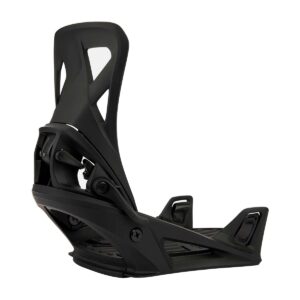
There are just called Step On Bindings, they don’t really have a model name other than that, which can be a bit confusing. These are the basic standard. They have a medium overall flex, so they will suit a wide range of riding styles and skills. If you don’t really know which bindings to choose, these are the safe choice.
- Single component baseplate and highback
- Nylon composite with 30% short glass
- Medium flex
- $299.95
Step on Genesis
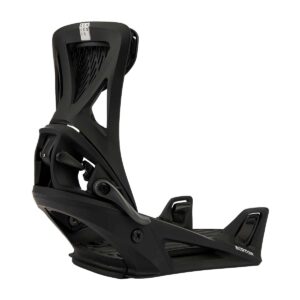
The Genesis are a step up in from the regular, but not really in a “performance” way. They have some extra suspension on the highback, the idea is that it will help push against the boot to smooth the riding out.
Although it has the higher price tag, it still only has the medium flex of the regular option, so anyone can ride the Genesis without a problem. Think of these as the upgraded bindings, but you won’t need to ride aggressively to get the most out of them.
- Single component baseplate
- Kickback hammock highback
- Medium flex
- $379.95
Step On X
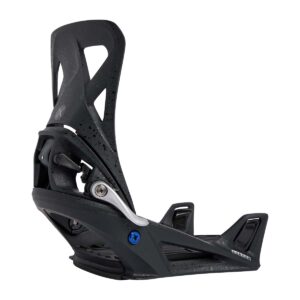
While the regular and Genesis are pretty similar in terms of real specs, the X makes a proper change. The X has a much stiffer overall flex than the previous models, as it is made with a 50:50 carbon fiber/nylon composite blend.
Both the baseplate and the highback have the 50:50 mix, which makes it light but stiff.
The X is the option for experienced riders, who like a stiffer and more responsive overall setup. I would also match these with at least the Photon or the Ion boots – so the flex of the boots is roughly in the same area as these bindings.
- Single component baseplate
- Stiff flex
- 50:50 carbon fiber/nylon composite blend
- $439.95
Read my review here
Step on Loback
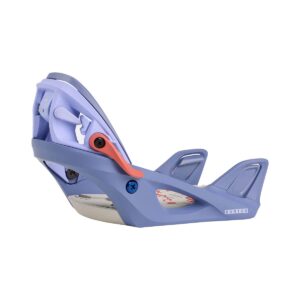
Basically these Loback bindings have the minimum needed to ride. All the same connections to the boot as normal, but no regular high back. When combined with the Sweetspot boots, you have a much more flexible setup, but it is really going to favour park riding.
- Medium flex
- $299.95
Step On Mine 77 est
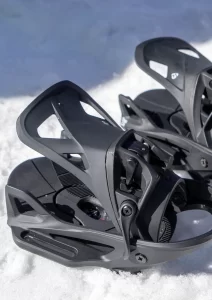
All of the other Step On options mount with the Re:Flex system – so they can be mounted on 4×4 or channel boards. If you are a die-hard Burton fan, you probably have their EST bindings. Less binding material overall, the idea is that you will get a better board feel, because the binding isn’t restricting the board from flexing as much.
While you can get better “board feel”, the tradeoff is that these won’t work on anything but Channel boards, so if you swap boards in the future, you will be limited to Burton options.
- Medium flex
- EST (channel boards only)
Step-On Bindings (womens)
Womens Step On Bindings (regular)

There are just called Step On Bindings, they don’t really have a model name other than that, which can be a bit confusing. These are the basic standard. They have a medium overall flex, so they will suit a wide range of riding styles and skills.
If you don’t really know which bindings to choose, these are the safe choice.
- Single component baseplate and highback
- Medium flex
- $299.95
Step on Escapade

The Escapade are a step up in from the regular, but not really in a “performance” way. They have some extra suspension on the highback, the idea is that it will help push against the boot to smooth the riding out.
Although it has the higher price tag, it still only has the medium flex of the regular option, so anyone can ride the Escapade without a problem.
- Single component baseplate
- Kickback hammock highback
- Medium flex
- $379.95
Womens Step On X

While the regular and Escapade are pretty similar in terms of real specs, the X makes a proper change. The X has a much stiffer overall flex than the previous models, as it is made with a 50:50 carbon fiber/nylon composite blend.
Both the baseplate and the highback have the 50:50 mix, which makes it light but stiff.
The X is the option for experienced riders, who like a stiffer and more responsive overall setup.
- Single component baseplate
- Stiff flex
- 50:50 carbon fiber/nylon composite blend
- $439.95
Womens Step on Loback

Basically these Loback bindings have the minimum needed to ride. All the same connections to the boot as normal, but no regular high back. When combined with the Sweetspot boots, you have a much more flexible setup, but it is really going to favour park riding.
- Medium flex
- $299.95
Step On Boot options
For the first couple of seasons, there many options for the boots. If you have feet that suit regular Burton boots then you would have been fine, but more specific fits were harder to deal with.
In either Step On or regular setups, the boots are by far the most important part of your riding gear. Getting the right fit is extremely important.
Now there is a fairly wide range of Step On compatible boots from Burton, Nitro and DC. All of them will have slightly different fits, so it is much more likely there is a suitable and comfortable boot, whatever type of foot you have.
There are boots with all the different lacing types: Burton Speed Zone, BOA, regular lace and Nitro TLS (twin lacing system).
As well as the different lacing systems, there are specific wide models in the mens and womens, as well as specific soft flexing options or their higher end boots.
What are the differences between Step On boots?
There are a few things that change on boot as they price goes up. Compared to regular laces or Speed Zone, boots with BOA cost more.
In general, the more that you spend on boots, the stiffer the overall flex gets. The exception to this is the Photon Soft (mens) and the Felix Soft (womens).
As well as the boots having a stiffer flex, there is more noticeable differences in the liner of the boot. As a rough rule, the higher the cost of the boot, the better heel hold you will have. When someone is talking about heel hold, they are referring to how well your heel or ankle is locked down to the bottom of the boot. The better it is held down, the more efficient every single toe side turn on your board will be.
Mens Boots
Burton Ruler Step On
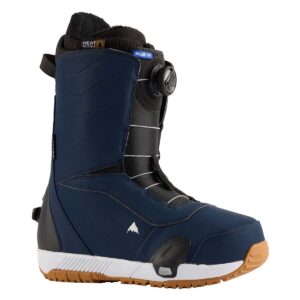
The Ruler is the entry level boot for the mens Step On system. It has a single BOA for tightening the boot, and the Imprint 2 liner. Overall this has a medium flex, but it is on the softer side overall.
You can get the Ruler in both the regular line of boots, as well as in the Step-Ons. Although it is the most basic Step-On boot, in the regular line of boots it is still above the entry level (and quite soft) Moto.
If you are a beginner to intermediate rider, or this is your first setup – then the softer flexing simple Ruler is the safe and more affordable choice.
- Medium-soft flex
- Imprint 2 liner
- $349.95
Burton Swath Step On
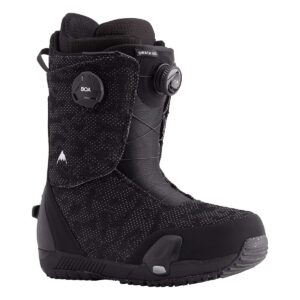
The next step up is the Swath. It is still rated as a medium flex, though it is a little bit stiffer than the Ruler.
It has a Dual Zone Boa system, which means that you have the ability to tighten the top and bottom of the boot separately. It also has a slightly more aggressive heel hold with the Imprint 3 liner.
The Swath is a lighter boot overall, and is aimed at freestyle or park riders. Separate than the liner upgrade, the key feature is being a double BOA boot. Even if you don’t care about riding a whole lot of park and want a boot for all-mountain, if you can make the jump from the single boa Ruler up to the Swath, it will be a good choice.
- Medium flex
- Imprint 3 liner
- $429.95
Burton Swath Sweetspot
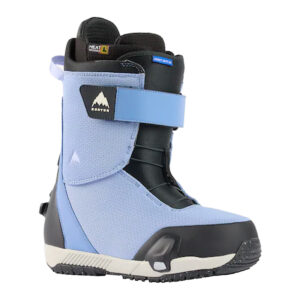
This is a new version of the Swash, and it has a slightly lower price than the regular Swash. No BOA on this one, but it has a combination of Speed Zone lacing to tighten the bottom of the boot, and a big velcro power strap to tighten the top. It still has the Imprint 3 liner.
These boots are designed to match up with the Loback Step On binding. Made to have a much softer overall flex, aimed at park or freestyle riders.
- Soft flex
- Speed Zone
- Powerstrap
- Imprint 3 liner
- $409.95
Burton Kendo Step On
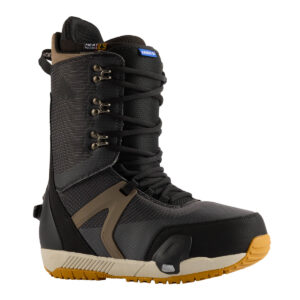
The Kendo is a very specific boot, the only option to have regular old school laces on a Step-On boot. I can’t imagine that this boot would end up being very popular in the long run, no matter how well it fits.
I imagine that the average rider who wants Step-Ons is looking to save time, making everything as quick and easy as possible. For most people, this it going to mean BOA boots, or maybe Nitro TLS.
- Medium-stiff flex
- Regular lace
- Imprint 3 liner
- $369.95
Burton Photon Step On
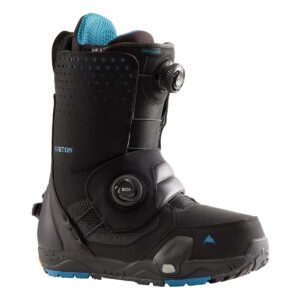
This is where the Burton options start to get a bit more serious. The Photon still technically has a medium overall flex, and the Imprint 3 liner.
Like the Swath this is also a double BOA boot, but the second BOA is handled a completely different way on the Photon.
The front BOA tightens the shell of the boot in the same way as the Ruler or any other single BOA boot.
The second BOA tightens what is pretty much an ankle strap. Depending on how tight you go, this will change how locked in your heel it, and slightly stiffen the flex of the boot (just while leaning forward).
- Medium flex
- Imprint 3 liner
- $479.95
Burton Photon Wide Step On

The wide version of the Photon has all the same features, but with softer panels on the inside of the liner, which stretch easily to handle people with a wider forefoot.
- Medium flex
- Wide fit
- Imprint 3 liner
- $479.95
Burton Photon Soft Step On
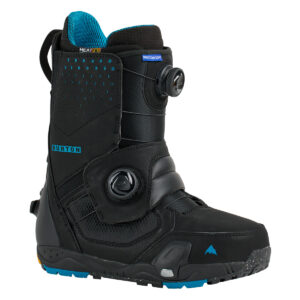
This is the option for riders who want the locked in feel of the Photon with the separate ankle strap, but want extra flexibility in the boots for a more relaxed ride. Sure, you could get a similar softer flex from a boot like the Ruler, but it isn’t going to have the heel hold you can get in the Photon.
- Soft flex
- Imprint 3 liner
- $479.95
Burton Ion Step On
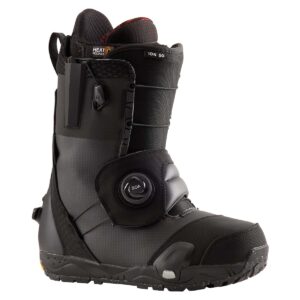
This is the top end of the Step On boots, the stiffest option you can get. A different lacing system again on this model, which gives even more options than the Photon.
It has a upper and lower Speed Zone lacing, as well as the same BOA ankle strap as the Photon.
- Stiff flex
- Speed Zone
- BOA
- $619.95
DC Control Step On
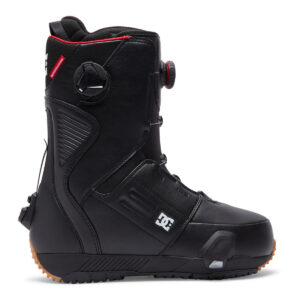
A medium flexing, double BOA option. DC say this is a 4/10 for flex.
- Stiff flex
- RII liner
- $389.95
DC Judge Step On
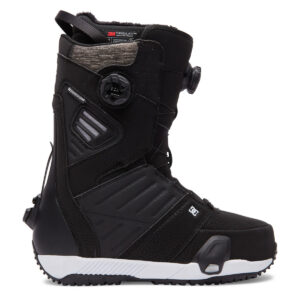
A stiffer flexing boot double BOA boot, that DC say is 6/10.
- Medium flex
- RIII liner
- $419.95
Nitro Profile Step On
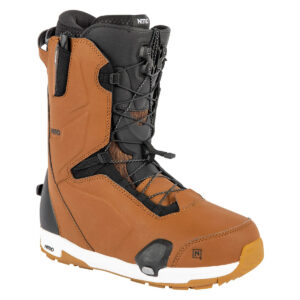
This has the Nitro TLS (twin lacing system), which is very quick to get in and out of once you learn the pattern. Similar to a double BOA boot, you have the ability to tighten the upper and lower of the boot separately to get the right fit. Nitro give it a flex rating of 8/10.
- 8/10 flex
- TLS lacing
- $429.95
Womens Boots
Burton Limelight Step On
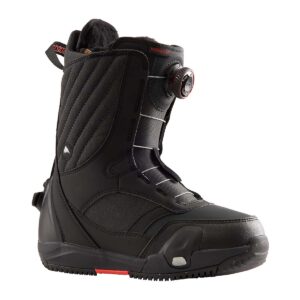
Simple, comfortable and affordable single boa boot. Although basic features, you can still expect a snug overall fit.
- Soft flex
- Imprint 2 liner
- $349.95
Burton Limelight Wide Step On

A version of the Limelight, that will suit riders with a bigger forefoot. The liner has stretchy panels which mean wider feet feel much less pressure.
- Soft flex
- Wide fit
- Imprint 2 liner
- $349.95
Burton Ritual Step On
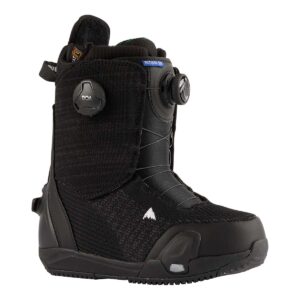
A medium flexing, double BOA boot. Pretty good shape around the ankle for better heel hold.
- Medium flex
- Imprint 3 liner
- $429.95
Burton Ritual Sweetspot
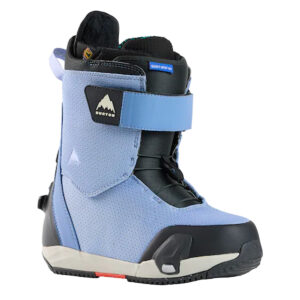
A soft flexing, Speed Zone and velcro strap boot, made to be matched with the Loback bindings.
- Soft flex
- Imprint 3 liner
- $409.95
Burton Felix Step On
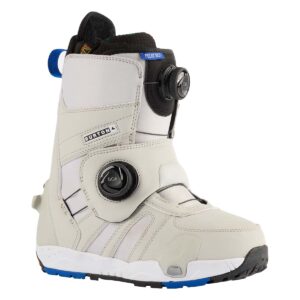
The Felix has the double BOA design (like the Photon), that is made to give a solid, but adjustable fit – that is around a medium flex. The front BOA on the tongue tightens the tongue, while the BOA on the ankle strap locks down the heel, and will slightly stiffen the boot a little – depending on how tight you go.
- Medium flex
- Imprint 3 liner
- $479.95
Burton Felix Soft Step On
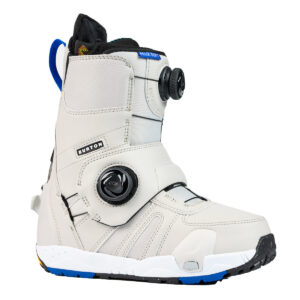
This is the softer flexing version of the Felix, which is going to make it the choice for riders who want a softer flexing boot overall, but still need good heel hold.
- Soft flex
- Imprint 3 liner
- $479.95
DC Mora Step On
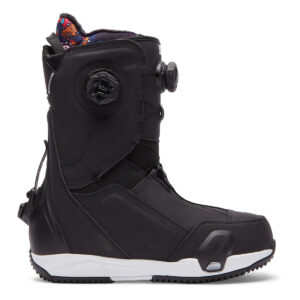
A medium flexing, double BOA option. DC say this is a 7/10 for flex.
- 7/10 flex
- Dual BOA
- R2 liner
- $399.95
Nitro Cave Step On
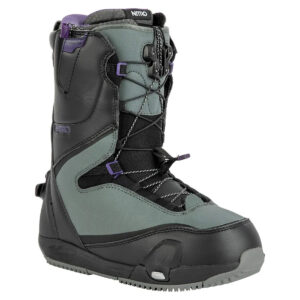
Made for riders who like the Nitro fit, speed of TLS lacing, and still want Step Ons.
- 7/10 flex
- TLS lacing
- $399.95
Which Step-On boots for wide feet?
If you have wider feet, you might have a bit of luck with any of the DC options. The safest choice overall, would be to go for the Burton Photon Wide for men, or the Burton Limelight Wide for women.
Step On for kids
For kids, or youth, there are the Zipline Step On, that match with the Kids Step On bindings.
Burton Step On Boot to Binding Size Chart
There is no wiggle room at all with the boot to binding connection, so you have to follow the size guide exactly. You can’t swap between mens and womens, so if you need a mens Large Step-On binding, it isn’t compatible with a womens Large.
Men
| Binding Size | S | M | L | XL |
|---|---|---|---|---|
| Men’s Boot Size | 6-8 | 8.5-10.5 | 11-13 | 14-15 |
Womens
| Binding Size | S | M | L |
|---|---|---|---|
| Women’s Boot Size | 5-6 | 6.5-8.5 | 9-11 |

Find the best price on the Complete Guide To Burton Step On Boots and Bindings